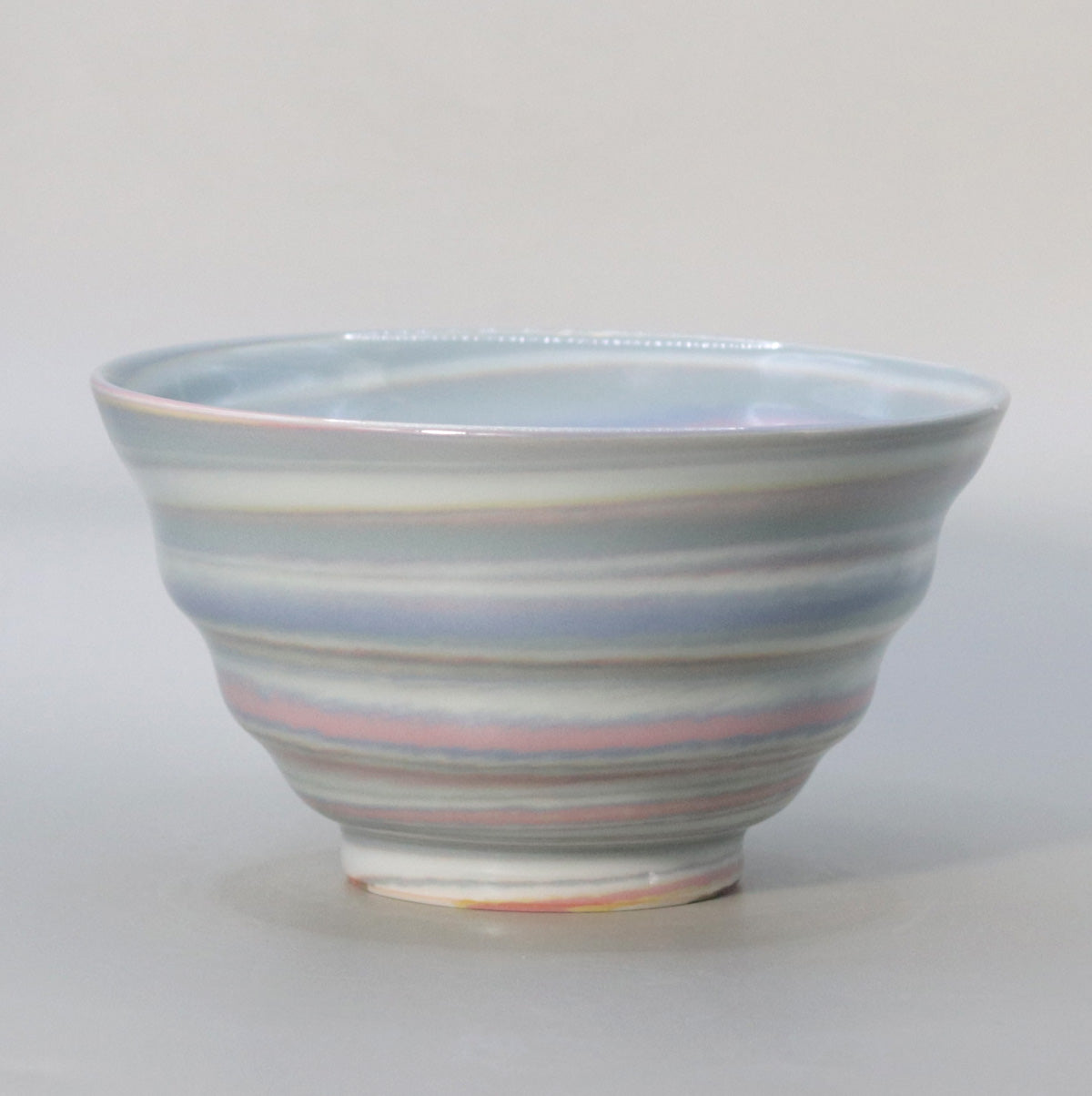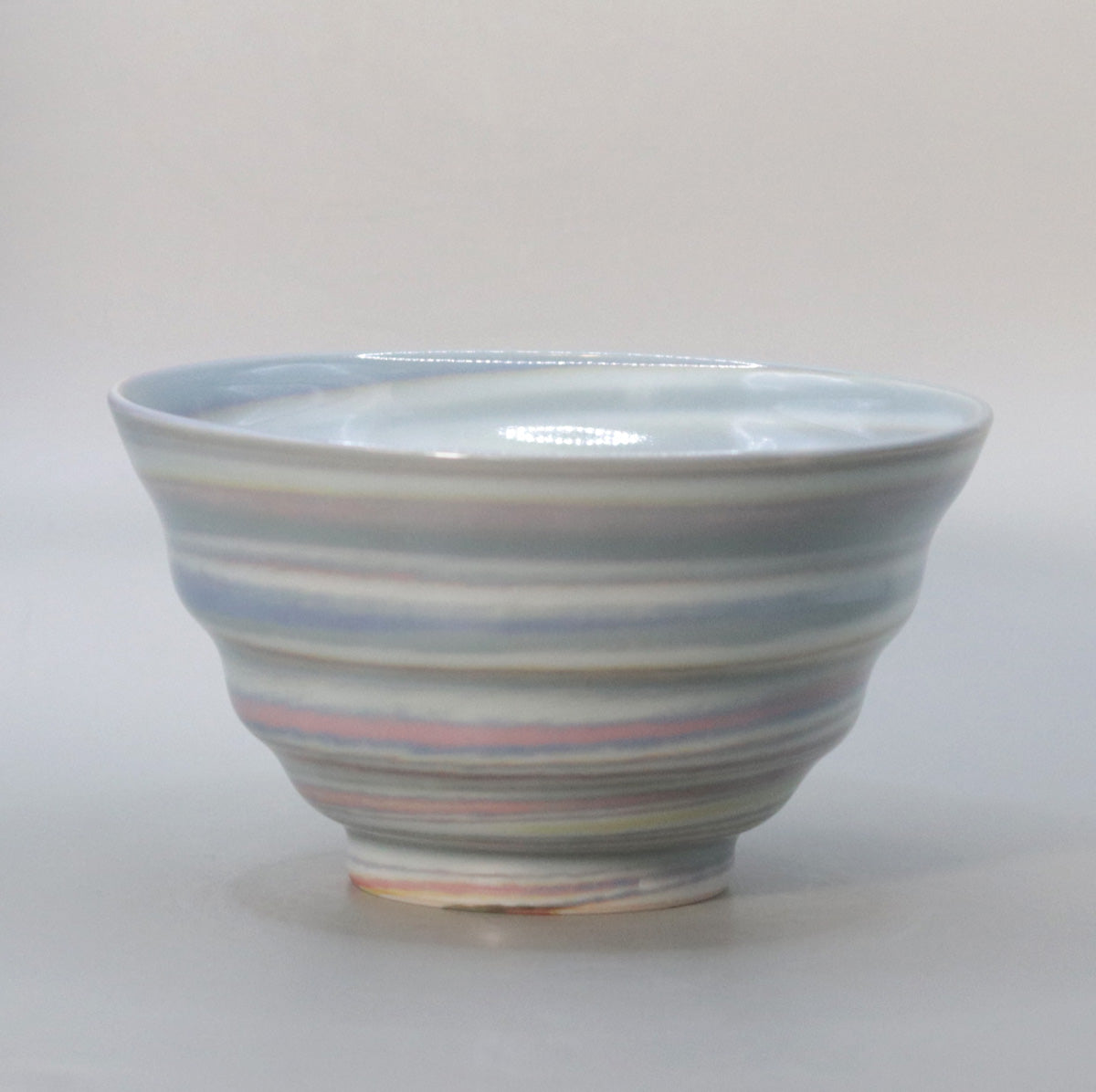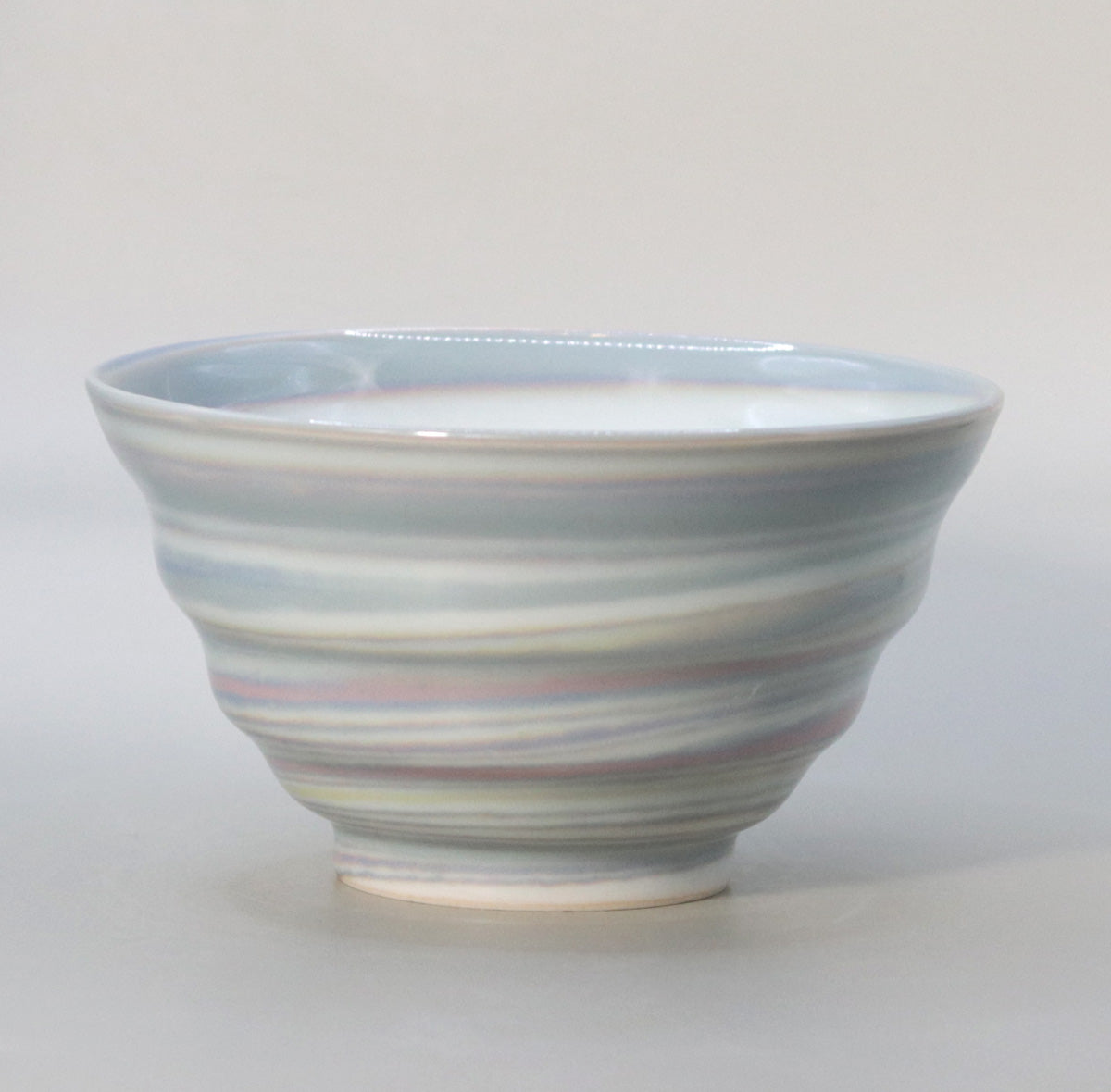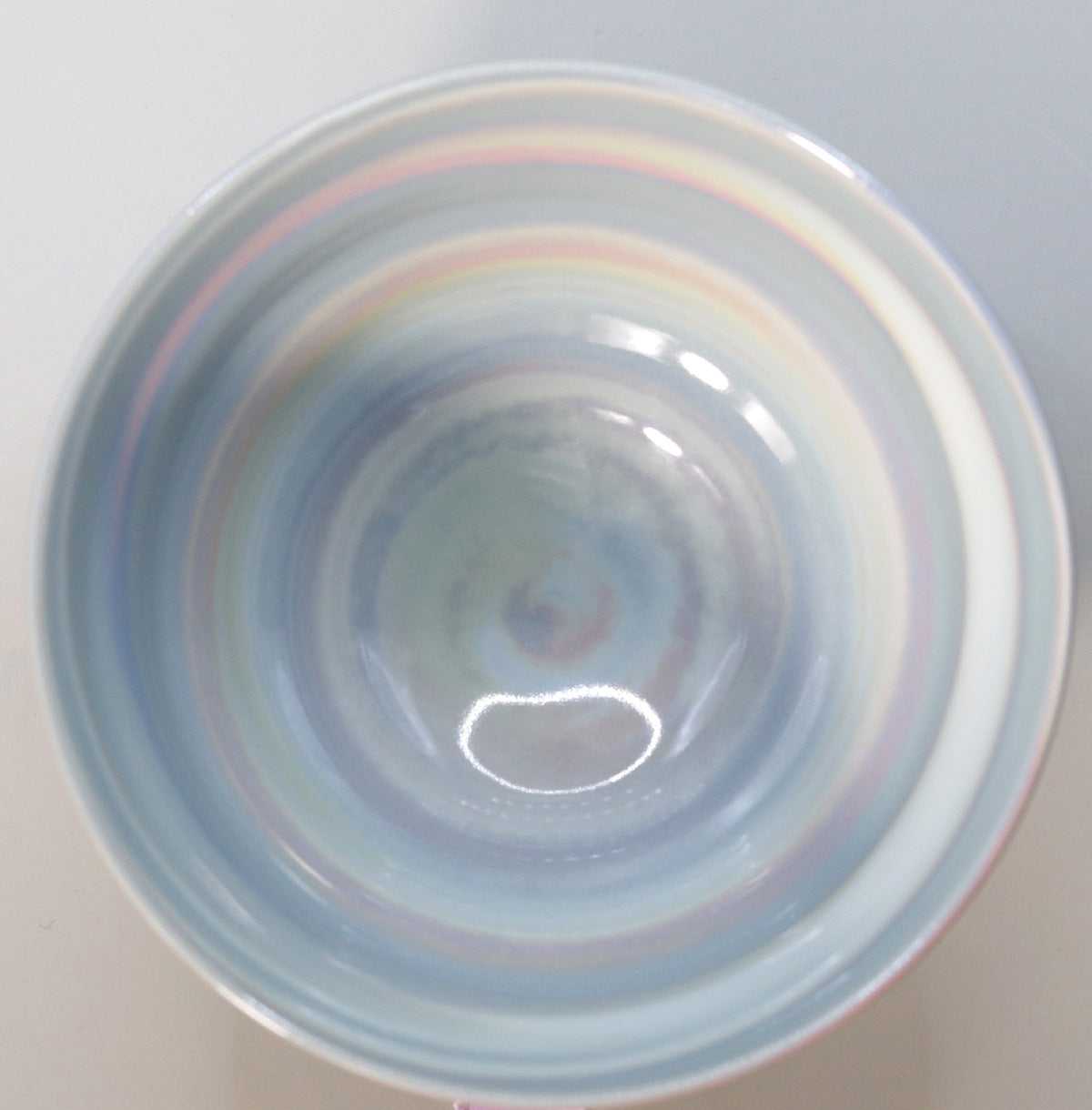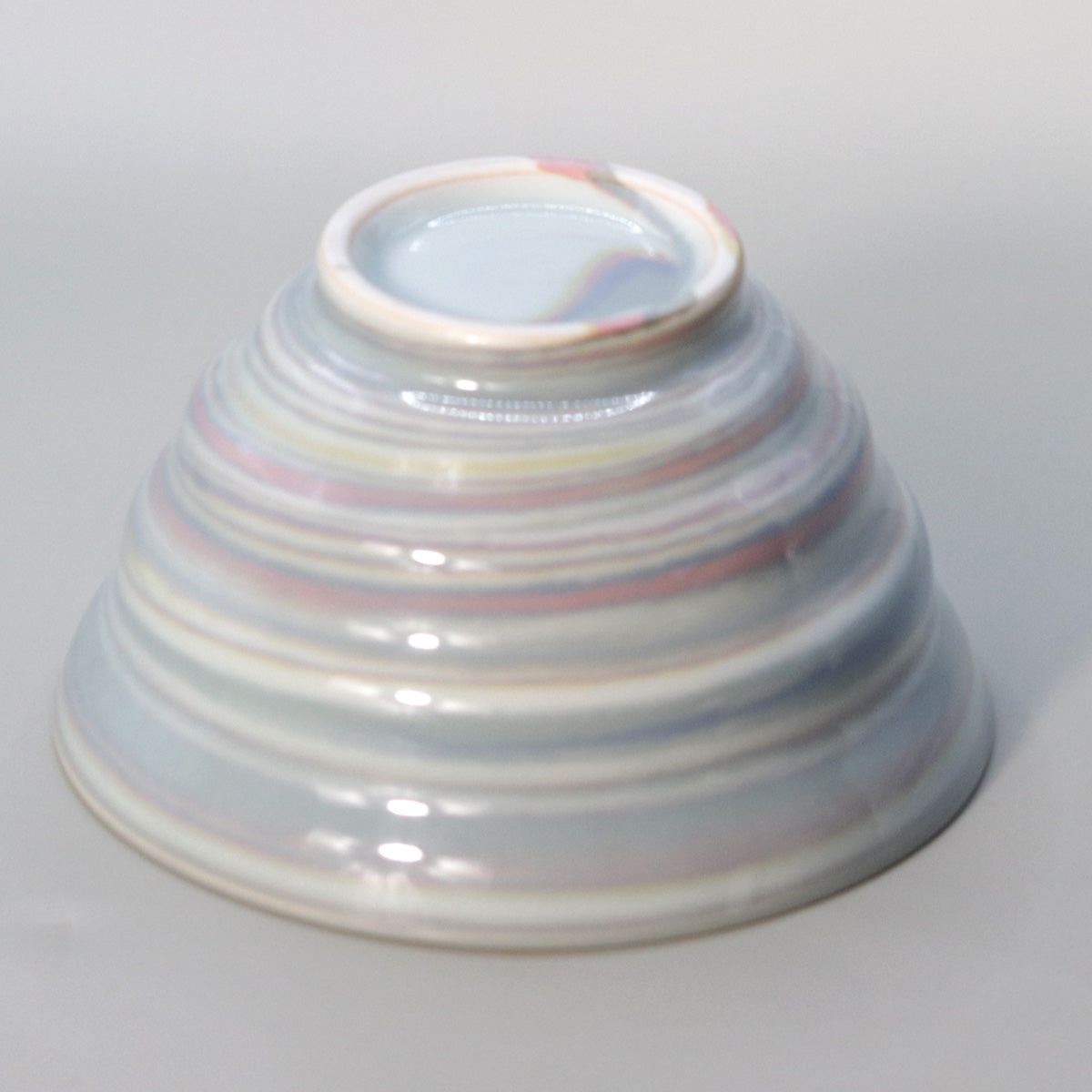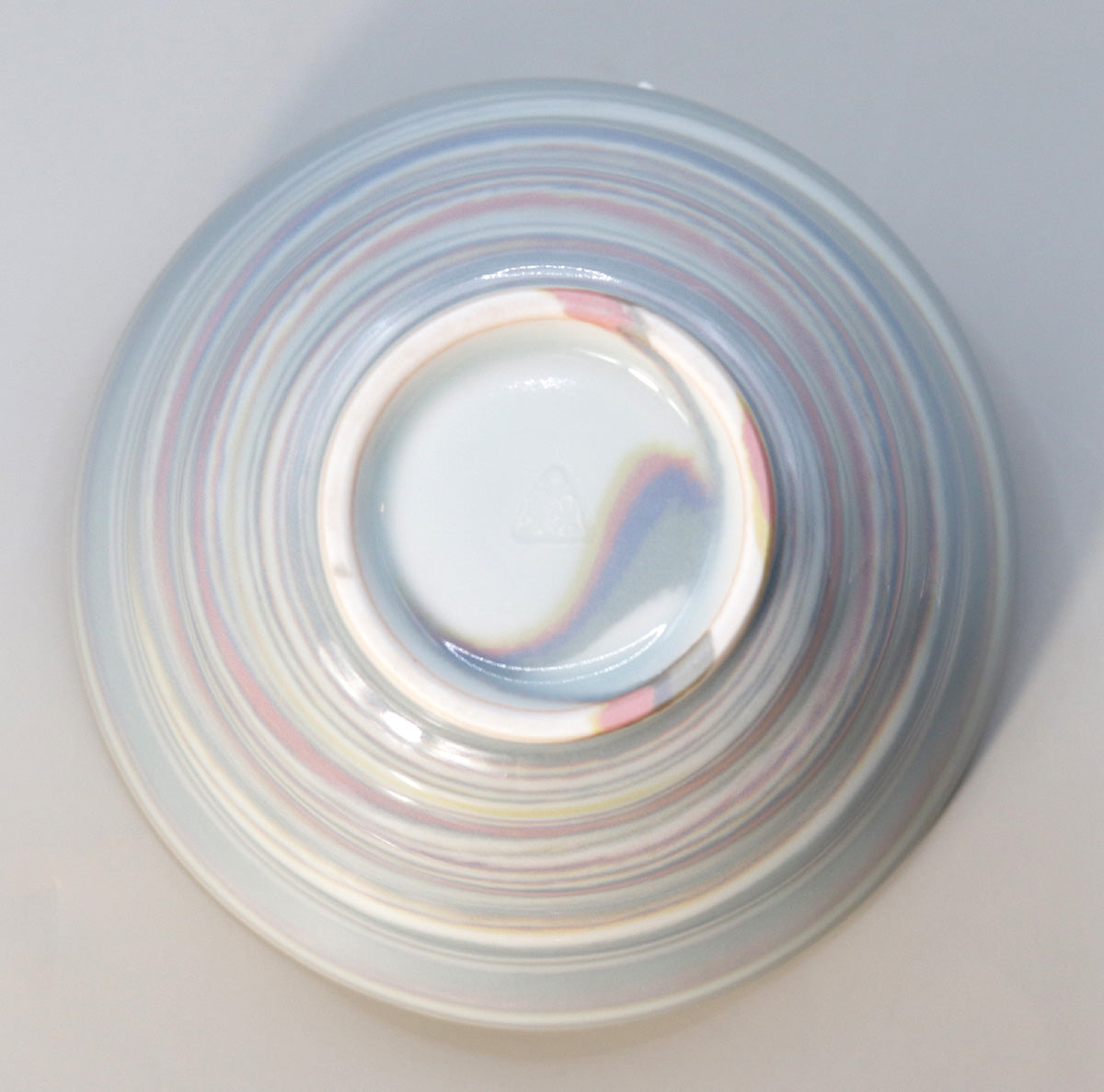Kneaded celadon twisted Akebono tea bowl by Suwa Sozan
Kneaded celadon twisted Akebono tea bowl by Suwa Sozan
Couldn't load pickup availability
Width: 13.0cm Height: 7.3cm
I. Work summary
This piece, "Nerikomi Seiki Neji-nuki Akebono Tea Bowl," was inspired by the famous phrase "Spring is the dawn" at the beginning of "The Pillow Book." It is a matcha bowl made using the "Neji-nuki" technique, in which five-colored porcelain clays of white, celadon, indigo, red, and yellow porcelain are layered and turned on a potter's wheel in one go, then twisted into a spiral shape while the body is still soft. The three-dimensional undulations of the Neji-nuki gently shake the horizontal gradation of the kneaded layers, projecting the color and atmosphere of "Akebono," which changes from ultramarine at night to pink and then a faint golden color, on the surface of the bowl. Neji-nuki with porcelain clay is much more difficult than with highly plastic ceramic clay, and requires advanced finger pressure and moisture control to create a spiral without destroying the five-colored layers.
II. Shape and form
Rhythm of the twisted body
The outer body is twisted clockwise in three stages to form wavy ridges. The five-colored stripes run diagonally, creating a three-dimensional image of clouds at dawn blowing in the wind.
Curved rim
The rim is slightly curved outwards so as not to interfere with the use of the tea whisk. The pale indigo line running along the rim suggests the afterglow of the morning sun, and the pool of glaze on the rim makes the jade green stand out even more.
Shallow depth and gentle elevation
The inside of the cup is shallow and wide, with the spiral layers gently converging towards the bottom. When the matcha is poured, the green liquid surface looks like a sea of clouds dyed in the dawn light. The base is carved out low and the shape spreads out gently outwards, making it comfortable to hold in the palm of your hand and light and airy. The yellow porcelain layer peeking out from the side of the base suggests the sunlight beginning to shine through.
III. The Nerikomi x Nenuki technique and glaze tones - Layers and spirals that embrace the "Akebono"
Layered Structure of Five-Colored Porcelain Clay <br data-end="799" data-start="796">White porcelain, celadon, blue porcelain, red porcelain, and yellow porcelain are rolled out into slabs, layered several times, and rolled into a cylinder, which is then shaped on a potter's wheel as a core of clay. As the layers rotate, they create horizontal stripes, and when twisted, they distort diagonally, creating a movement that resembles bands of clouds fluttering in the wind. No two tea bowls have the same appearance.
A veil of transparent celadon glaze <br data-end="944" data-start="941">After shaping, the entire piece is covered in a highly transparent celadon glaze and then reduced-fired. The glaze layer becomes a glassy membrane that softly envelops the internal layered pattern and gives it depth. The celadon layer suggests the afterglow of the night, the crimson layer the rose hue of dawn, the yellow porcelain layer the morning sun beginning to shine, and the white porcelain layer melts everything together like a mist.
The feel of the glaze surface <br data-end="1098" data-start="1095">The glaze surface is smooth, and feels as if it is moist and clinging to your fingertips. While you enjoy the visual swirls and layers, the tranquility of the texture passes through your palms and soothes your mind.
Ⅳ. Functional beauty and arrangement at tea ceremonies
| season | Recommended main dessert | Synergistic effect with tea bowls |
|---|---|---|
| early spring | Cherry potato and plum blossom jelly | The crimson layer is reminiscent of a floral mist, softly highlighting the pale pink of the confectionery. |
| summer | Water peony and kudzu bun | The celadon and blue porcelain layers emphasize the cool feeling and bring out the refreshing taste of the transparent confectionery. |
| autumn | Moon Viewing Dumplings and Kikujido | The yellow porcelain layer suggests the light of the harvest moon, deepening the charm of the autumn night. |
| winter | Yuzu Mochi/Yukihira | The white porcelain layers evoke a snowy landscape, while the green of the matcha accentuates the signs of life. |
Harmony with Matcha <br data-end="1485" data-start="1482">The vivid green of the matcha emerges from the spiral layers, creating a visual effect as if the “stirring of spring” is present inside the bowl.
Lighting Effects <br data-end="1555" data-start="1552">When illuminated by the warm light of a lantern or candle, the red and yellow porcelain layers glow softly, while the blue porcelain layer deepens the pre-dawn silence. The mysterious scenery is particularly striking in the evening seating.
V. Literary background and technical significance
"The Pillow Book" and "Akebono"
Sei Shonagon's painting "Akebono" is a momentary feast of colors where darkness and light intertwine. Suwa Sozan IV has translated these words into five-colored porcelain clay and spiral movements, attempting a new expression of celadon that crosses the boundaries of literature and ceramics.
The rarity of twisted threads
Nejiku is a technique originally suited to ceramic clay, and there are very few successful examples when used with porcelain clay, as it is prone to cracking and distortion. This piece achieves both layers and spirals through advanced humidity control and finger pressure control, which allows the kneaded layers to be twisted evenly without breaking them.
The Challenge of the Yellow Magnet Layer
Yellow porcelain is difficult to make as it easily loses color during reduction firing, but by adding traces of iron and titanium to the kaolin, a pale lemon yellow color is achieved. The complementary color relationship with the indigo blue layer accentuates the brilliance of "Akebono."
Ⅵ. Artist profile and creative approach
The 4th Suwa Sozan (born in Kyoto in 1970) was trained by the 3rd Suwa Sozan and the 12th Nakamura Sotetsu , a lacquer artist, and took over the name in 2002. Based on his research into celadon, he uses a variety of techniques such as Hotarude, Tobiseiji, and Nerikomi Celadon, and upholds the philosophy that "a piece should have a story and be completed in harmony with the user's heart." This tea bowl is filled with the desire to deliver the breath of spring to the moment of tea ceremony, entrusting the "hope that sprouts between night and morning" to the spiral of the twisted thread.
VII. Conclusion
The "Kneaded Celadon Twisted Dawn Tea Bowl" is a masterpiece that combines the tranquil jade-colored celadon with the indigo twilight, crimson twilight, and yellow morning light, and further expresses the movement of clouds at dawn with a three-dimensional twisted spiral. When matcha is poured into it, the green light dyes the dawn sky, inviting a literary atmosphere and seasonal change to the tea ceremony. This work, which crystallizes the outstanding technique and poetic sensibility of Suwa Sozan IV, envelops the venue with dignity and dynamism rather than luxury, and will surely bring a calm hope and a breath of new life to the hearts of those who see it.
Share
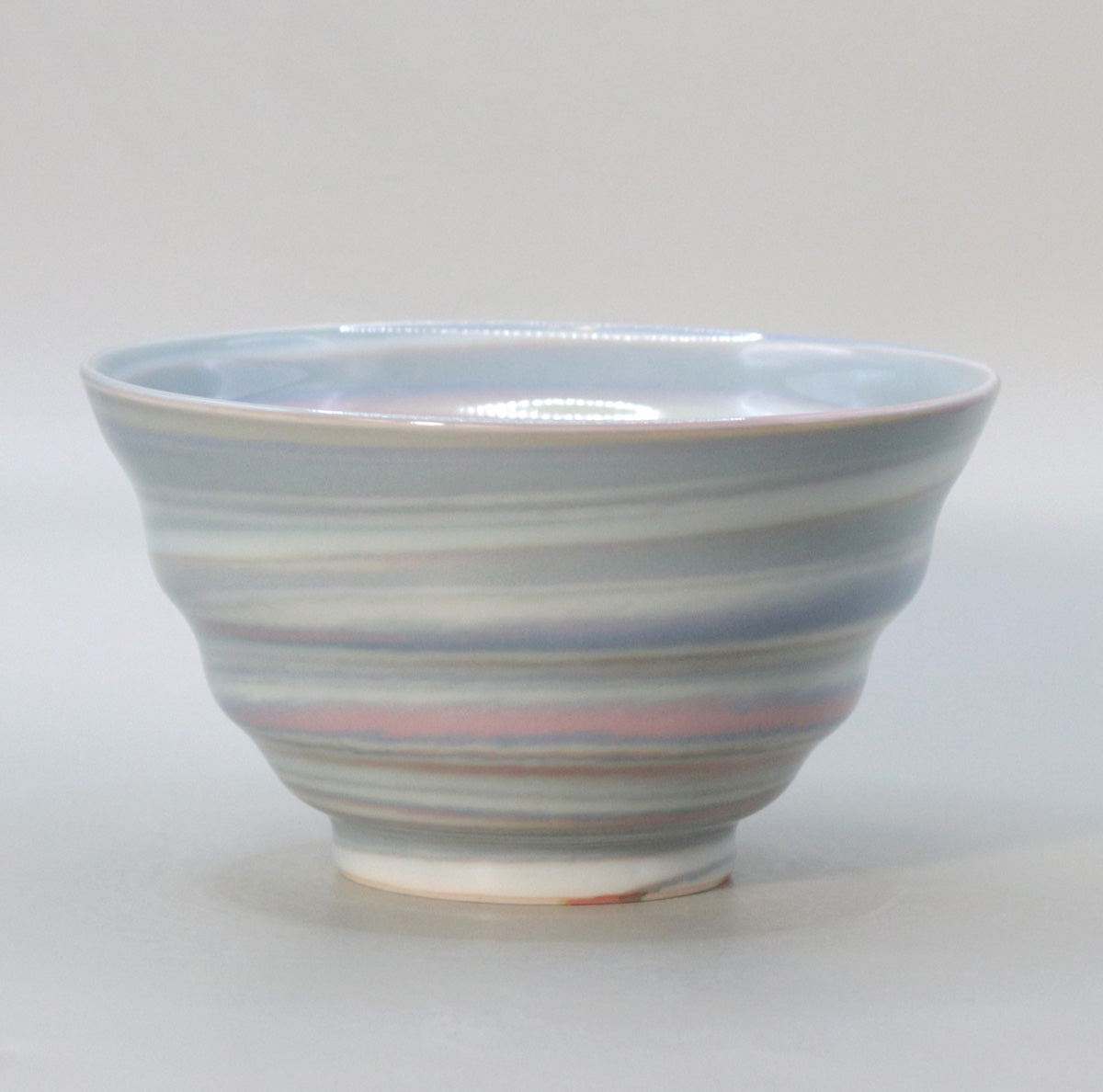



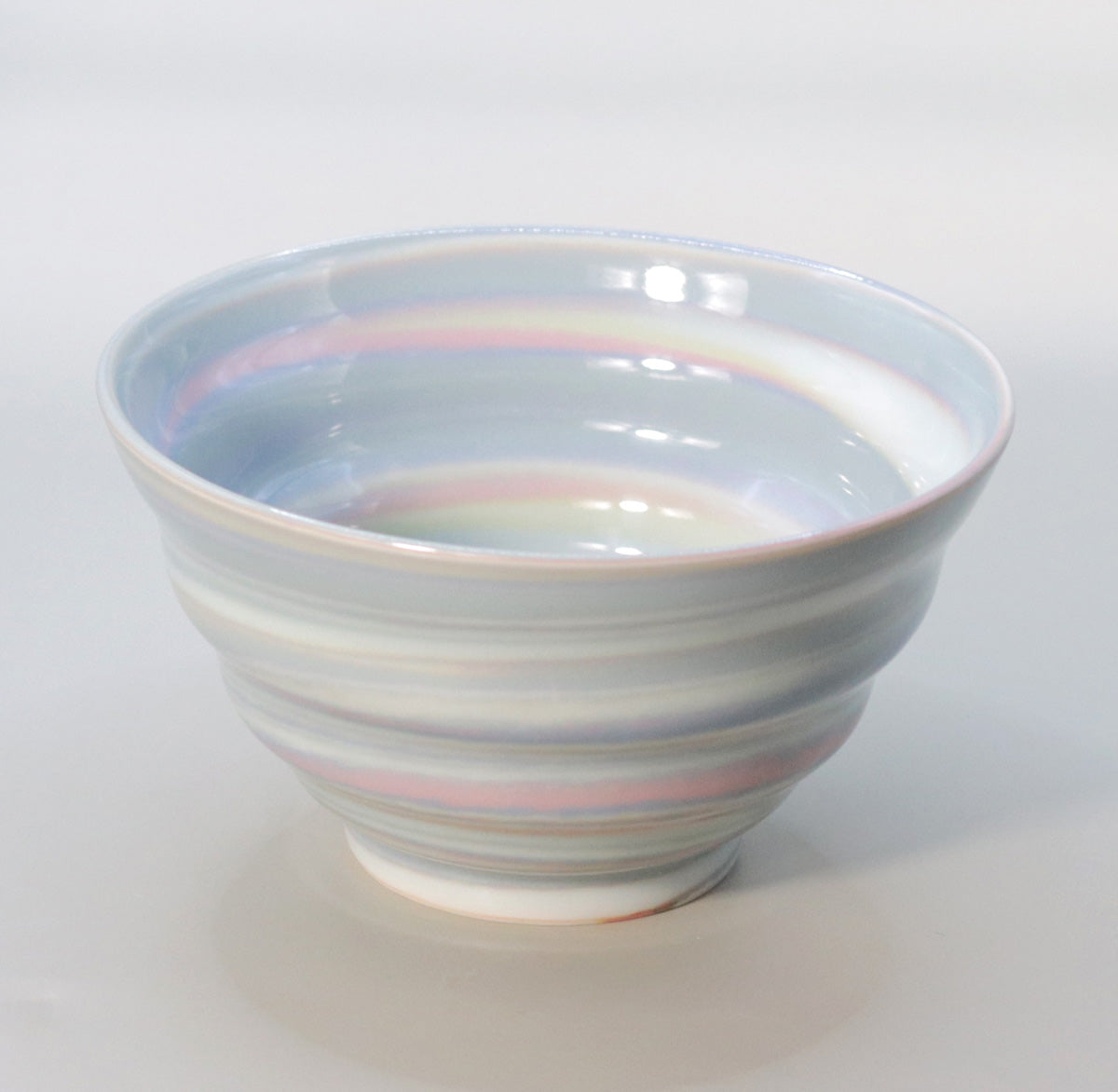
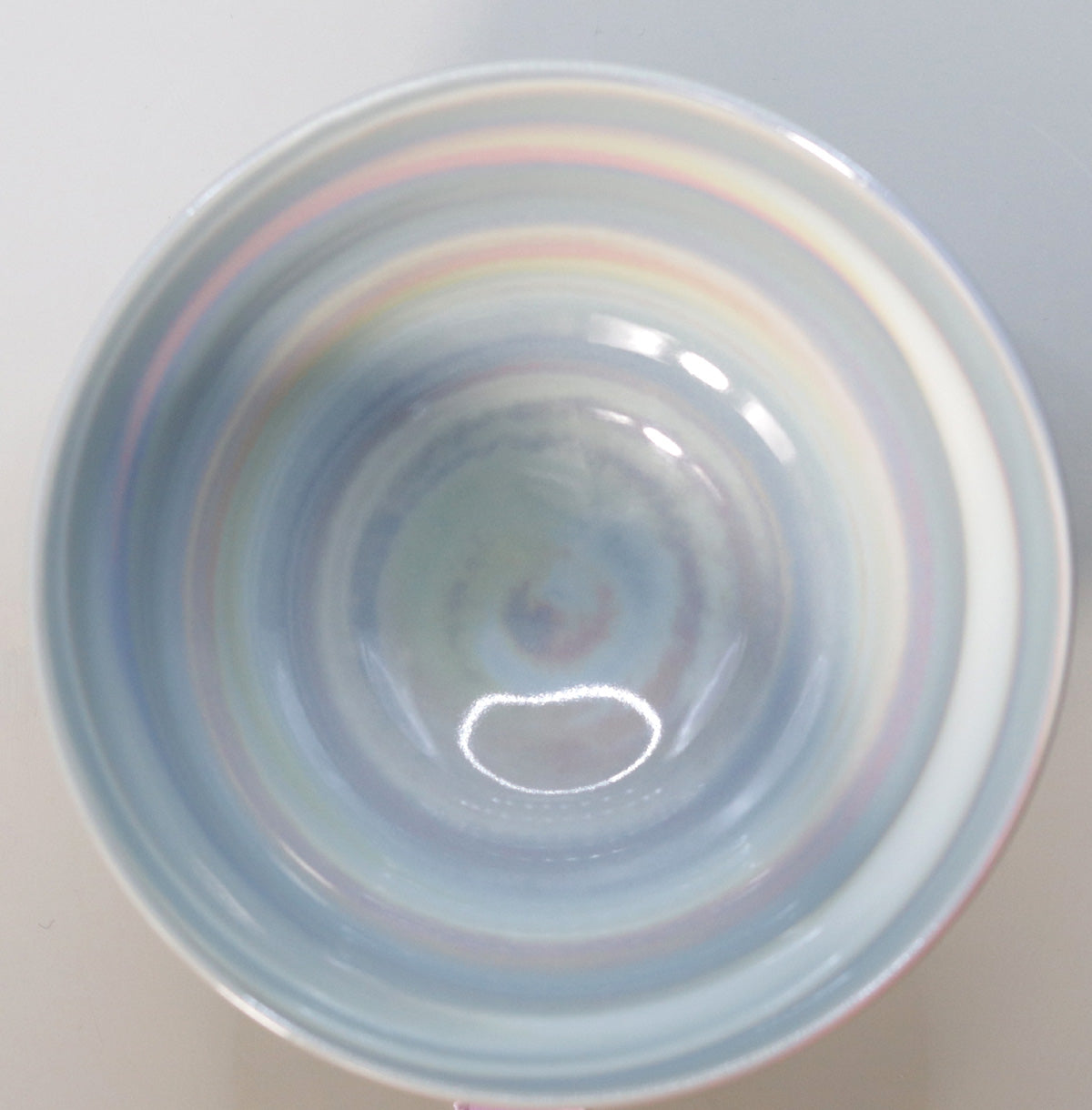
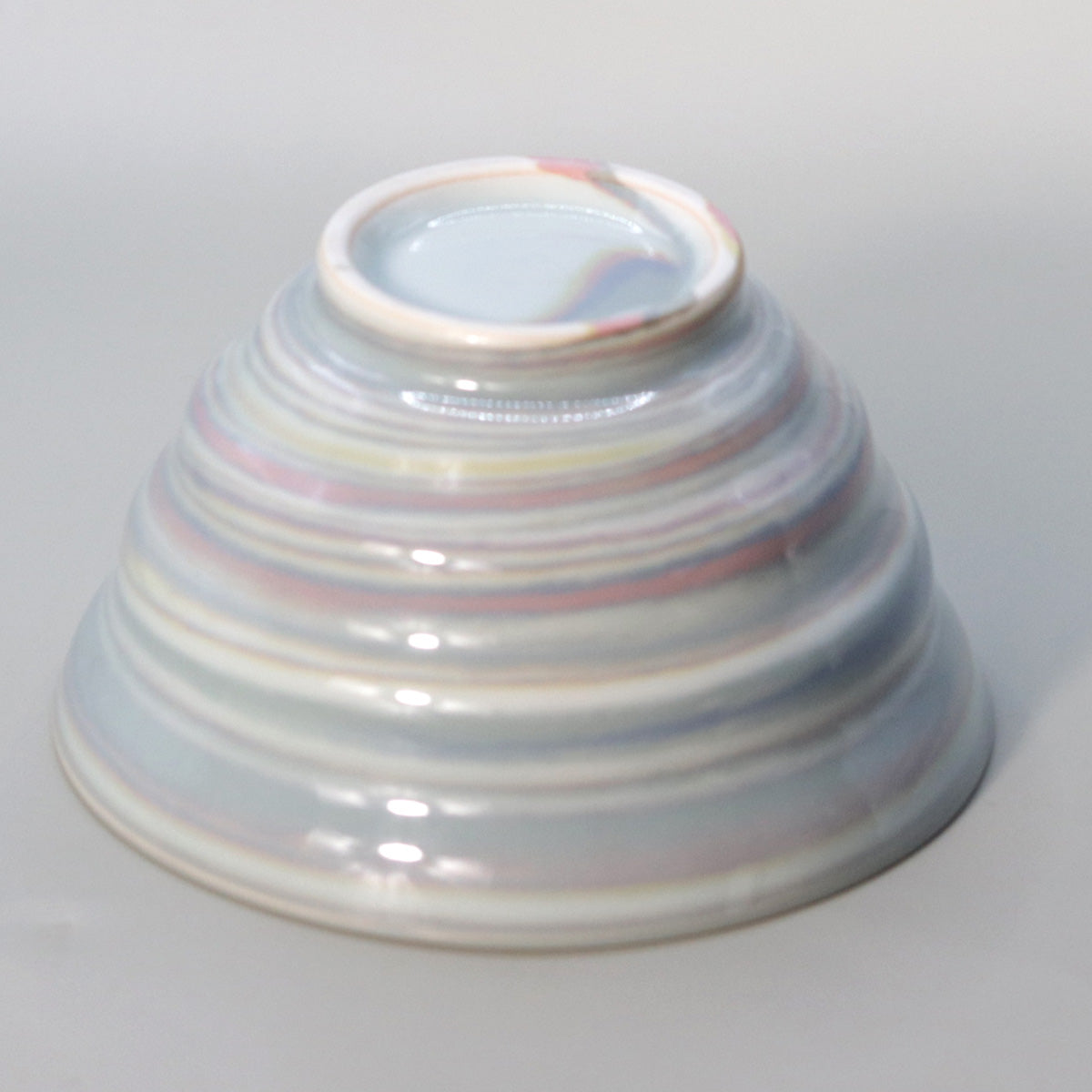

Multi-Column
-
[I will send it to you quickly and carefully]
We carefully package each product in a way that suits it best.
Also, delivery times vary depending on the piece (vessel, etc.).
Items that already come with a box will be shipped within 1-3 days of the order date.
For items that require a box to be made after your order, it will take approximately 30 days for production to be completed and then shipped.
In either case, once we have confirmed your order, we will contact you by email to inform you of the delivery date.
-
[Requests when purchasing pottery]
Even products that look the same may differ slightly in color, shape, size, etc.
The way the glaze is used, the power of the kiln, the firing method, the season, and the humidity also affect the appearance of the pottery.
Please understand the individuality of each piece of pottery and enjoy the unique warmth of handmade.


